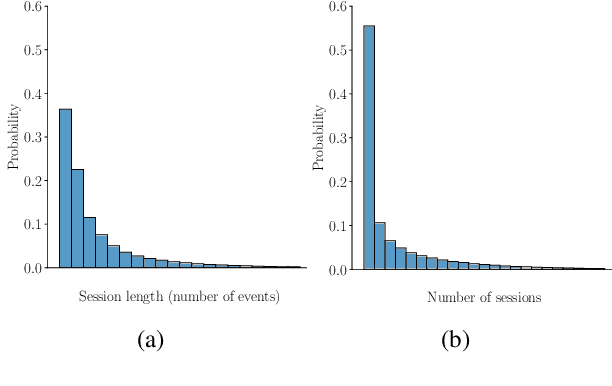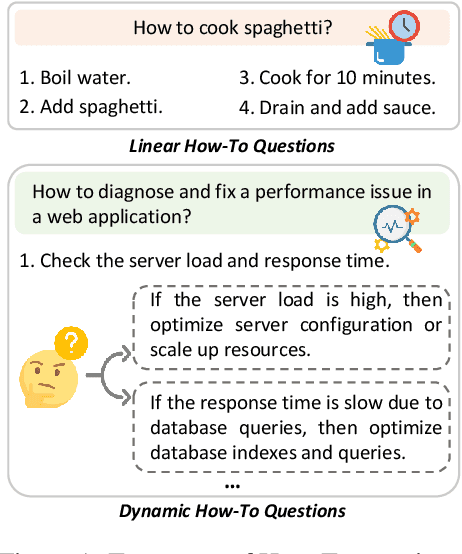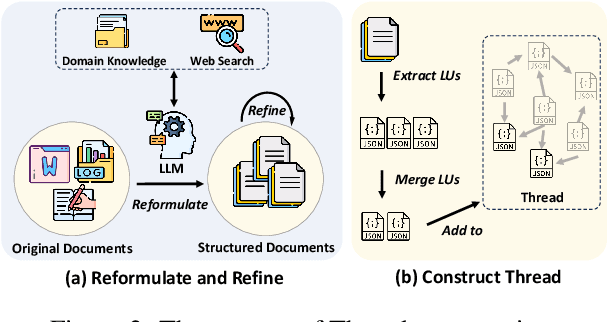Lele Cao
Are We Really Measuring Progress? Transferring Insights from Evaluating Recommender Systems to Temporal Link Prediction
Jun 14, 2025Abstract:Recent work has questioned the reliability of graph learning benchmarks, citing concerns around task design, methodological rigor, and data suitability. In this extended abstract, we contribute to this discussion by focusing on evaluation strategies in Temporal Link Prediction (TLP). We observe that current evaluation protocols are often affected by one or more of the following issues: (1) inconsistent sampled metrics, (2) reliance on hard negative sampling often introduced as a means to improve robustness, and (3) metrics that implicitly assume equal base probabilities across source nodes by combining predictions. We support these claims through illustrative examples and connections to longstanding concerns in the recommender systems community. Our ongoing work aims to systematically characterize these problems and explore alternatives that can lead to more robust and interpretable evaluation. We conclude with a discussion of potential directions for improving the reliability of TLP benchmarks.
Towards bandit-based prompt-tuning for in-the-wild foundation agents
Feb 10, 2025Abstract:Prompting has emerged as the dominant paradigm for adapting large, pre-trained transformer-based models to downstream tasks. The Prompting Decision Transformer (PDT) enables large-scale, multi-task offline reinforcement learning pre-training by leveraging stochastic trajectory prompts to identify the target task. However, these prompts are sampled uniformly from expert demonstrations, overlooking a critical limitation: Not all prompts are equally informative for differentiating between tasks. To address this, we propose an inference time bandit-based prompt-tuning framework that explores and optimizes trajectory prompt selection to enhance task performance. Our experiments indicate not only clear performance gains due to bandit-based prompt-tuning, but also better sample complexity, scalability, and prompt space exploration compared to prompt-tuning baselines.
Enhancing Pre-Trained Decision Transformers with Prompt-Tuning Bandits
Feb 10, 2025Abstract:Harnessing large offline datasets is vital for training foundation models that can generalize across diverse tasks. Offline Reinforcement Learning (RL) offers a powerful framework for these scenarios, enabling the derivation of optimal policies even from suboptimal data. The Prompting Decision Transformer (PDT) is an offline RL multi-task model that distinguishes tasks through stochastic trajectory prompts, which are task-specific tokens maintained in context during rollouts. However, PDT samples these tokens uniformly at random from per-task demonstration datasets, failing to account for differences in token informativeness and potentially leading to performance degradation. To address this limitation, we introduce a scalable bandit-based prompt-tuning method that dynamically learns to construct high-performance trajectory prompts. Our approach significantly enhances downstream task performance without modifying the pre-trained Transformer backbone. Empirical results on benchmark tasks and a newly designed multi-task environment demonstrate the effectiveness of our method, creating a seamless bridge between general multi-task offline pre-training and task-specific online adaptation.
On the Power of Heuristics in Temporal Graphs
Feb 07, 2025Abstract:Dynamic graph datasets often exhibit strong temporal patterns, such as recency, which prioritizes recent interactions, and popularity, which favors frequently occurring nodes. We demonstrate that simple heuristics leveraging only these patterns can perform on par or outperform state-of-the-art neural network models under standard evaluation protocols. To further explore these dynamics, we introduce metrics that quantify the impact of recency and popularity across datasets. Our experiments on BenchTemp and the Temporal Graph Benchmark show that our approaches achieve state-of-the-art performance across all datasets in the latter and secure top ranks on multiple datasets in the former. These results emphasize the importance of refined evaluation schemes to enable fair comparisons and promote the development of more robust temporal graph models. Additionally, they reveal that current deep learning methods often struggle to capture the key patterns underlying predictions in real-world temporal graphs. For reproducibility, we have made our code publicly available.
Unified Approaches in Self-Supervised Event Stream Modeling: Progress and Prospects
Feb 07, 2025



Abstract:The proliferation of digital interactions across diverse domains, such as healthcare, e-commerce, gaming, and finance, has resulted in the generation of vast volumes of event stream (ES) data. ES data comprises continuous sequences of timestamped events that encapsulate detailed contextual information relevant to each domain. While ES data holds significant potential for extracting actionable insights and enhancing decision-making, its effective utilization is hindered by challenges such as the scarcity of labeled data and the fragmented nature of existing research efforts. Self-Supervised Learning (SSL) has emerged as a promising paradigm to address these challenges by enabling the extraction of meaningful representations from unlabeled ES data. In this survey, we systematically review and synthesize SSL methodologies tailored for ES modeling across multiple domains, bridging the gaps between domain-specific approaches that have traditionally operated in isolation. We present a comprehensive taxonomy of SSL techniques, encompassing both predictive and contrastive paradigms, and analyze their applicability and effectiveness within different application contexts. Furthermore, we identify critical gaps in current research and propose a future research agenda aimed at developing scalable, domain-agnostic SSL frameworks for ES modeling. By unifying disparate research efforts and highlighting cross-domain synergies, this survey aims to accelerate innovation, improve reproducibility, and expand the applicability of SSL to diverse real-world ES challenges.
Expressivity of Representation Learning on Continuous-Time Dynamic Graphs: An Information-Flow Centric Review
Dec 05, 2024Abstract:Graphs are ubiquitous in real-world applications, ranging from social networks to biological systems, and have inspired the development of Graph Neural Networks (GNNs) for learning expressive representations. While most research has centered on static graphs, many real-world scenarios involve dynamic, temporally evolving graphs, motivating the need for Continuous-Time Dynamic Graph (CTDG) models. This paper provides a comprehensive review of Graph Representation Learning (GRL) on CTDGs with a focus on Self-Supervised Representation Learning (SSRL). We introduce a novel theoretical framework that analyzes the expressivity of CTDG models through an Information-Flow (IF) lens, quantifying their ability to propagate and encode temporal and structural information. Leveraging this framework, we categorize existing CTDG methods based on their suitability for different graph types and application scenarios. Within the same scope, we examine the design of SSRL methods tailored to CTDGs, such as predictive and contrastive approaches, highlighting their potential to mitigate the reliance on labeled data. Empirical evaluations on synthetic and real-world datasets validate our theoretical insights, demonstrating the strengths and limitations of various methods across long-range, bi-partite and community-based graphs. This work offers both a theoretical foundation and practical guidance for selecting and developing CTDG models, advancing the understanding of GRL in dynamic settings.
Understanding Players as if They Are Talking to the Game in a Customized Language: A Pilot Study
Oct 24, 2024



Abstract:This pilot study explores the application of language models (LMs) to model game event sequences, treating them as a customized natural language. We investigate a popular mobile game, transforming raw event data into textual sequences and pretraining a Longformer model on this data. Our approach captures the rich and nuanced interactions within game sessions, effectively identifying meaningful player segments. The results demonstrate the potential of self-supervised LMs in enhancing game design and personalization without relying on ground-truth labels.
Refining Counterfactual Explanations With Joint-Distribution-Informed Shapley Towards Actionable Minimality
Oct 07, 2024Abstract:Counterfactual explanations (CE) identify data points that closely resemble the observed data but produce different machine learning (ML) model outputs, offering critical insights into model decisions. Despite the diverse scenarios, goals and tasks to which they are tailored, existing CE methods often lack actionable efficiency because of unnecessary feature changes included within the explanations that are presented to users and stakeholders. We address this problem by proposing a method that minimizes the required feature changes while maintaining the validity of CE, without imposing restrictions on models or CE algorithms, whether instance- or group-based. The key innovation lies in computing a joint distribution between observed and counterfactual data and leveraging it to inform Shapley values for feature attributions (FA). We demonstrate that optimal transport (OT) effectively derives this distribution, especially when the alignment between observed and counterfactual data is unclear in used CE methods. Additionally, a counterintuitive finding is uncovered: it may be misleading to rely on an exact alignment defined by the CE generation mechanism in conducting FA. Our proposed method is validated on extensive experiments across multiple datasets, showcasing its effectiveness in refining CE towards greater actionable efficiency.
Thread: A Logic-Based Data Organization Paradigm for How-To Question Answering with Retrieval Augmented Generation
Jun 19, 2024



Abstract:Current question answering systems leveraging retrieval augmented generation perform well in answering factoid questions but face challenges with non-factoid questions, particularly how-to queries requiring detailed step-by-step instructions and explanations. In this paper, we introduce Thread, a novel data organization paradigm that transforms documents into logic units based on their inter-connectivity. Extensive experiments across open-domain and industrial scenarios demonstrate that Thread outperforms existing data organization paradigms in RAG-based QA systems, significantly improving the handling of how-to questions.
Causality for Tabular Data Synthesis: A High-Order Structure Causal Benchmark Framework
Jun 12, 2024Abstract:Tabular synthesis models remain ineffective at capturing complex dependencies, and the quality of synthetic data is still insufficient for comprehensive downstream tasks, such as prediction under distribution shifts, automated decision-making, and cross-table understanding. A major challenge is the lack of prior knowledge about underlying structures and high-order relationships in tabular data. We argue that a systematic evaluation on high-order structural information for tabular data synthesis is the first step towards solving the problem. In this paper, we introduce high-order structural causal information as natural prior knowledge and provide a benchmark framework for the evaluation of tabular synthesis models. The framework allows us to generate benchmark datasets with a flexible range of data generation processes and to train tabular synthesis models using these datasets for further evaluation. We propose multiple benchmark tasks, high-order metrics, and causal inference tasks as downstream tasks for evaluating the quality of synthetic data generated by the trained models. Our experiments demonstrate to leverage the benchmark framework for evaluating the model capability of capturing high-order structural causal information. Furthermore, our benchmarking results provide an initial assessment of state-of-the-art tabular synthesis models. They have clearly revealed significant gaps between ideal and actual performance and how baseline methods differ. Our benchmark framework is available at URL https://github.com/TURuibo/CauTabBench.
 Add to Chrome
Add to Chrome Add to Firefox
Add to Firefox Add to Edge
Add to Edge